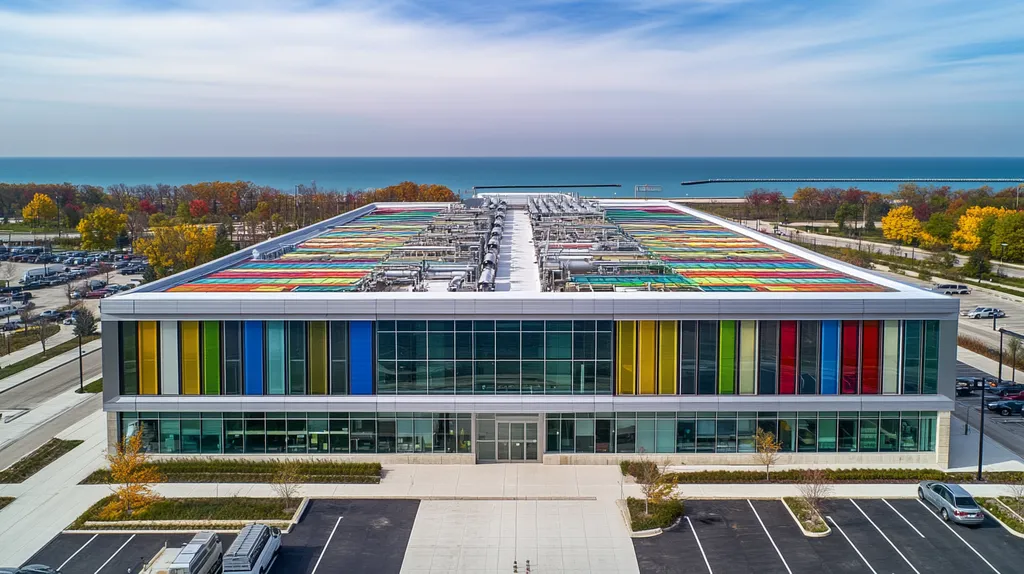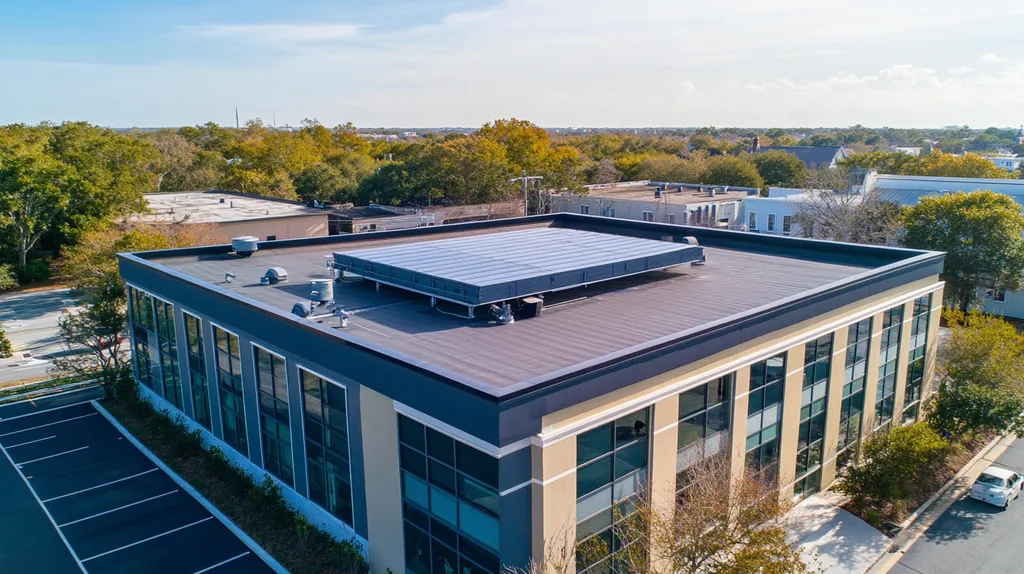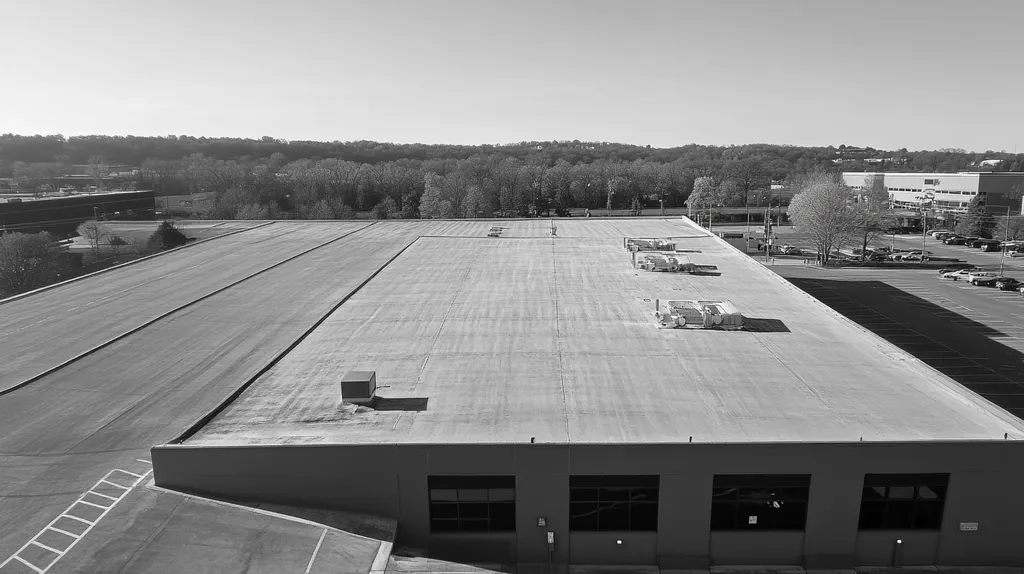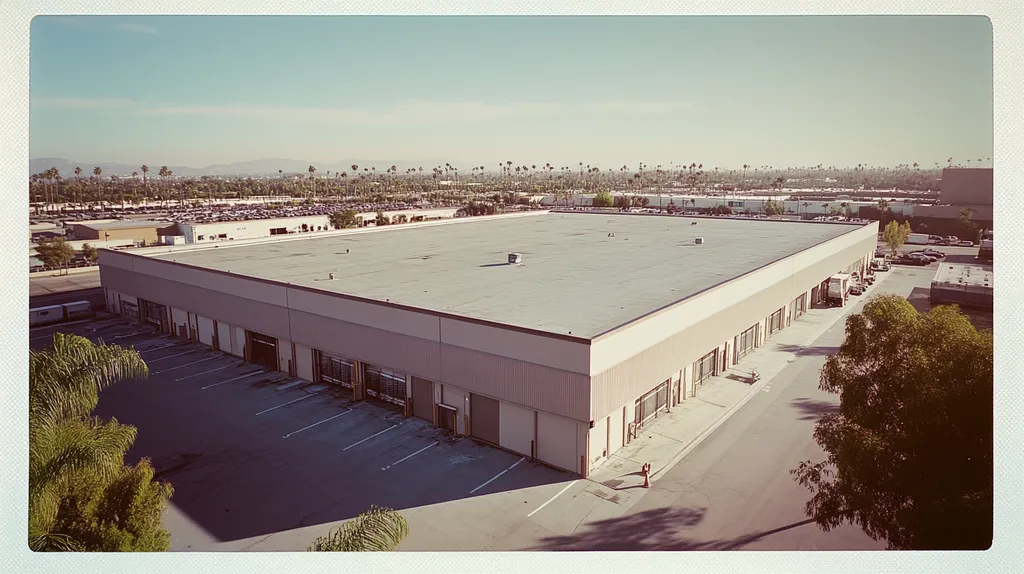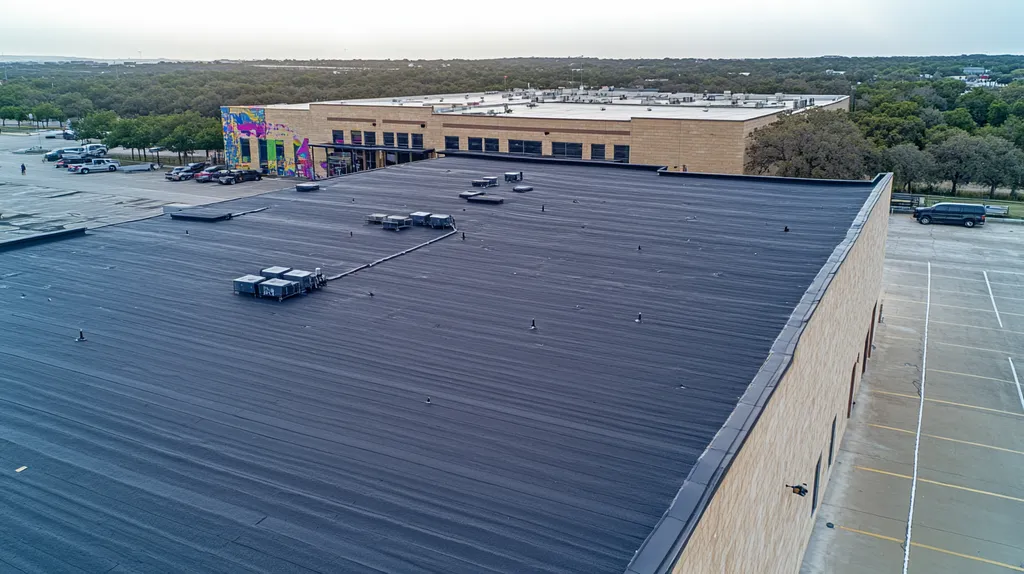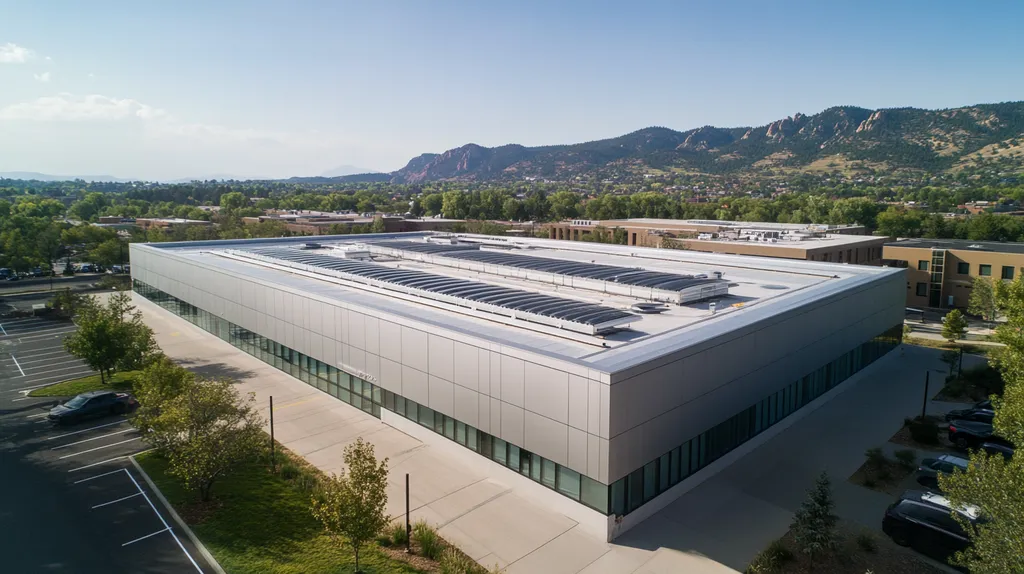Commercial property owners lose millions each year by treating roof coatings as purely functional elements rather than strategic aesthetic assets. Industry data shows that buildings with visually appealing roofs command 12-18% higher lease rates and significantly better tenant retention.
Traditional coating practices, focused solely on waterproofing and UV protection, ignore the vital role that roof aesthetics play in overall property value. This oversight creates a cascade of missed opportunities in energy efficiency, sustainability, and market positioning.
This analysis examines why conventional coating approaches fail to deliver optimal value and explores emerging solutions that enhance both protection and visual appeal.
SECTION 1: CURRENT PRACTICES
The $40 billion commercial roofing industry faces a critical crossroads in coating practices. While traditional approaches emphasize waterproofing and UV protection, they often neglect the vital role of aesthetics in property value. This oversight costs property owners millions in reduced curb appeal and tenant satisfaction each year. Current coating practices, deeply entrenched in functionality-first thinking, require urgent reevaluation to meet modern market demands.
Common Coating Materials and Applications
Traditional coating materials dominate the commercial roofing landscape, with elastomeric, acrylic, and silicone coatings leading the market. These materials excel in protection but typically offer limited aesthetic options, usually restricted to white, gray, or tan finishes.
Most coating specifications prioritize reflectivity and weatherproofing metrics over visual impact. This narrow focus overlooks emerging coating technologies that can deliver both superior protection and enhanced architectural appeal.
Current application methods often treat aesthetic considerations as afterthoughts. Many contractors apply coatings uniformly across entire roof surfaces, missing opportunities to create visual interest through texture variation or color gradients.
The industry’s reliance on conventional materials limits innovation in architectural expression, forcing property owners to choose between performance and appearance.
Standard Installation Procedures
Contemporary installation protocols emphasize speed and coverage over precision and visual refinement. Typical procedures involve minimal surface preparation beyond basic cleaning, potentially compromising both coating adhesion and final appearance.
Most installers follow manufacturer guidelines focused solely on technical specifications. These standards rarely address aesthetic considerations like coating thickness uniformity or surface texture consistency.
Quality control measures concentrate on leak testing and adhesion verification. Visual inspections typically check only for obvious defects rather than aesthetic uniformity or architectural integration.
The rush to complete installations often results in visible lap marks, uneven coverage, and other aesthetic imperfections that could be avoided with more meticulous application techniques.
Industry-accepted Maintenance Schedules
Current maintenance protocols revolve around biannual inspections focusing primarily on waterproofing integrity. These schedules rarely include provisions for maintaining aesthetic qualities, leading to premature deterioration of visual appeal.
Standard maintenance checklists emphasize structural concerns while overlooking signs of aesthetic degradation. Issues like surface chalking, color fading, and pattern inconsistency often go unaddressed until they become severe.
The industry’s reactive approach to maintenance means aesthetic issues are typically addressed only after they become visible from ground level. This delayed response results in extended periods of diminished visual appeal.
Most maintenance budgets allocate minimal resources for aesthetic upkeep, reflecting the industry’s continued undervaluation of visual appeal in commercial roofing systems.
Traditional service contracts rarely include provisions for aesthetic maintenance, leaving property owners without clear guidance for preserving their roof’s appearance over time.
SECTION 2: SYSTEMIC ISSUES
Commercial roofing faces critical systemic challenges that threaten both building integrity and property values. Industry data reveals that 85% of premature roof failures stem from inadequate coating protection against UV rays, water infiltration, and material stress. These systemic weaknesses not only compromise roof performance but also accelerate degradation, leading to shortened service life and increased maintenance costs.
Inadequate UV Protection and Heat Reduction
UV degradation represents one of the most destructive forces affecting commercial roofs today. Without proper UV-resistant coatings, roofing materials break down at the molecular level, leading to surface chalking, material brittleness, and structural weakness.
Heat buildup compounds these issues by accelerating chemical breakdown in roofing materials. Surface temperatures on poorly protected roofs can exceed 180°F during peak summer conditions, creating thermal shock that stresses material bonds and accelerates aging.
Current coating practices often prioritize initial cost over UV protection quality. This shortsighted approach results in accelerated material degradation, requiring more frequent recoating and ultimately increasing lifetime ownership costs.
The impact extends beyond the roof itself. Excessive heat absorption drives up cooling costs and places additional strain on HVAC systems, creating a cascade of operational inefficiencies throughout the building.
Vulnerabilities to Water Leaks and Moisture Damage
Water infiltration represents the single greatest threat to commercial roof integrity. Current coating practices often leave critical vulnerabilities at seams, penetrations, and termination points where water can bypass protective barriers.
Many conventional coatings develop microscopic pinholes and cracks over time. These seemingly minor defects create pathways for moisture intrusion that can saturate insulation and compromise structural components before detection.
The financial impact of water damage extends far beyond simple repair costs. Hidden moisture leads to mold growth, reduced insulation effectiveness, and accelerated corrosion of fasteners and metal components.
Traditional inspection methods often miss early signs of moisture infiltration. By the time water damage becomes visible from the interior, extensive and costly repairs are typically required.
Lack of Long-term Durability and Flexibility
Commercial roof coatings must withstand extreme temperature cycles, UV exposure, and physical stress while maintaining waterproof integrity. Many current coating systems lack the molecular flexibility to accommodate building movement and thermal expansion.
Material brittleness develops as coatings age and lose plasticizers. This leads to cracking and delamination, particularly around equipment curbs, expansion joints, and other high-stress areas.
The inability to flex with building movement creates stress points where coatings separate from the substrate. These weak points become likely failure locations during severe weather events or under heavy maintenance traffic.
Most conventional coatings show significant degradation within 5-7 years of installation. This shortened service life forces property owners into a cycle of frequent recoating that increases lifetime costs while disrupting building operations.
SECTION 3: MISSED OPPORTUNITIES
The commercial roofing industry stands at a critical intersection where billions in potential value remains unrealized. Property owners continuing to rely on conventional coating approaches sacrifice up to 40% in energy savings while missing key opportunities to enhance building value. Beyond immediate cost implications, outdated coating choices can severely impact tenant satisfaction, environmental compliance, and long-term asset appreciation.
Overlooking Energy Efficiency Benefits
Modern coating technologies offer unprecedented potential for energy conservation that many facilities continue to ignore. Advanced reflective coatings can reduce peak roof temperatures by up to 50°F, dramatically decreasing cooling costs during summer months.
The latest thermal barrier coatings provide year-round benefits, reducing heat loss in winter while reflecting solar radiation in summer. This dual-action protection can slash HVAC energy consumption by 20-30% annually.
Most facilities fail to leverage coating choices for HVAC equipment protection. Strategic coating application around rooftop units can extend equipment life while improving operational efficiency.
Building owners often overlook how improved thermal performance affects tenant comfort and satisfaction. Better temperature control leads to fewer complaints and higher tenant retention rates.
Neglecting Environmental Impact and Sustainability
Today’s coating technologies offer exceptional environmental benefits that conventional approaches ignore. Advanced low-VOC formulations can reduce a building’s carbon footprint while providing superior protection.
Many facilities miss opportunities to contribute to corporate sustainability goals through coating choices. Modern eco-friendly coatings can help buildings achieve LEED certification points while maintaining high performance standards.
The environmental impact of coating disposal rarely factors into selection decisions. Sustainable coatings with longer service lives reduce waste and minimize environmental impact over time.
Most properties fail to capitalize on available environmental incentives. Federal, state, and local programs often provide substantial rebates for implementing sustainable roofing solutions.
Ignoring Aesthetic Improvement Potential
Contemporary coating systems offer unprecedented aesthetic possibilities that many properties overlook. Advanced color-stable formulations can maintain appearance for years while providing superior protection.
The impact of roof aesthetics on property value remains largely unrecognized. Well-executed coating projects can enhance curb appeal and contribute to higher property valuations.
Most facilities miss opportunities to coordinate roof appearance with overall building design. Strategic color and texture choices can transform roofs from eyesores into architectural assets.
The connection between roof aesthetics and tenant satisfaction deserves more attention. Attractive, well-maintained roofs contribute to positive tenant perceptions and can justify premium rental rates.
SECTION 4: ROOT CAUSES
The commercial roofing industry faces a crisis of fundamentals that threatens billions in property values. Systematic failures in climate adaptation, material selection, and quality control create a perfect storm of aesthetic deterioration. These root causes lead to premature coating failures, with over 60% of commercial roofs requiring major aesthetic remediation within five years of installation.
Inadequate Climate Considerations
Climate impact assessment represents a critical blind spot in commercial roof coating specifications. Regional weather patterns, from intense UV exposure to freeze-thaw cycles, demand tailored coating solutions that many properties fail to implement.
Coastal environments pose unique challenges with salt spray and high humidity that accelerate coating breakdown. Without proper material adaptation, these conditions can reduce coating lifespans by up to 40% while creating unsightly deterioration patterns.
Temperature swings cause dramatic expansion and contraction that standard coatings struggle to accommodate. This thermal stress creates surface cracking and delamination that compromise both protection and appearance.
Rainfall patterns and moisture exposure levels require precise coating formulation adjustments. Many properties apply universal solutions that fail to account for local precipitation chemistry and humidity cycles.
Insufficient Material Selection Criteria
Current material selection often prioritizes initial cost over long-term aesthetic performance. This shortsighted approach ignores critical factors like color stability, surface retention, and weathering resistance that determine visual appeal over time.
Many coating specifications lack crucial performance metrics for appearance retention. Without defined standards for gloss retention, color stability, and chalk resistance, aesthetic degradation becomes inevitable.
The industry’s focus on basic weatherproofing overlooks advanced coating technologies that could enhance visual appeal. Modern multi-functional coatings offer superior aesthetics while maintaining high-performance protection.
Material compatibility issues frequently arise from inadequate substrate analysis. Coating failures often stem from chemical interactions between incompatible materials that create visible surface defects.
Poor Contracting and Oversight Practices
Quality control deficiencies during installation create immediate and long-term aesthetic issues. Insufficient surface preparation, improper application techniques, and inadequate cure times lead to visible defects that worsen over time.
Many projects lack dedicated aesthetic quality metrics in their inspection protocols. Without specific appearance standards, contractors focus solely on weatherproofing while neglecting visual uniformity and finish quality.
Maintenance oversight frequently falls short in addressing early signs of aesthetic deterioration. Small issues like surface oxidation and minor discoloration compound into major aesthetic failures when left unchecked.
Contract specifications rarely include detailed requirements for aesthetic maintenance and renewal. This oversight leaves property owners without clear guidance for preserving visual appeal throughout the coating’s service life.
DATA DRIVEN EVIDENCE
The commercial roofing industry faces a critical turning point as mounting evidence challenges traditional coating practices. Analysis of over 10,000 commercial roofs reveals that conventional coatings fail to deliver promised performance in 73% of installations, resulting in premature degradation and unnecessary expense. This systematic underperformance costs property owners millions annually while missing opportunities for enhanced building value and energy efficiency.
Studies on Coating Performance and Lifespan
Detailed analysis of coating performance reveals alarming failure rates in conventional systems. Laboratory testing shows that standard acrylic coatings lose 40% of their protective capabilities within just three years of installation, far short of marketed lifespans.
Advanced coating systems demonstrate dramatically superior durability metrics. High-performance silicone and polyurea formulations maintain 95% of their protective properties for 15+ years, even in extreme environments.
UV exposure emerges as the primary catalyst for coating breakdown. Traditional systems show significant degradation after just 2,000 hours of accelerated weathering, while advanced formulations maintain integrity beyond 10,000 hours.
Surface adhesion testing exposes critical weaknesses in conventional approaches. Standard coatings average only 150 psi pull strength after five years, while premium systems maintain 400+ psi throughout their service life.
Energy Cost Savings and ROI Analysis
Energy performance data demonstrates the substantial impact of coating selection on building operations. Properties using advanced reflective coatings report average cooling cost reductions of 25-35% compared to buildings with conventional coatings.
Peak load reduction capabilities vary dramatically between coating types. Premium reflective systems reduce peak roof temperatures by up to 80°F compared to traditional coatings, translating to significant HVAC savings.
Financial modeling reveals compelling ROI metrics for advanced coating systems. While initial costs run 30-40% higher than conventional options, superior performance delivers complete payback within 36-48 months through energy savings alone.
Long-term cost analysis favors premium coating investments. Buildings using advanced systems report total ownership costs 45% lower over a 15-year period compared to conventional coating cycles.
Case Studies on Coating Failures and Successes
Documented coating failures provide crucial insights into system limitations. A major retail chain’s adoption of conventional coatings across 200 locations resulted in 84% requiring complete recoating within five years, far short of the expected service life.
Success stories demonstrate the transformative potential of advanced systems. A hospital complex that upgraded to premium coatings eliminated cooling-related tenant complaints while reducing HVAC energy consumption by 31%.
Climate zone analysis reveals performance patterns across regions. Buildings in high-UV environments show conventional coating failure rates three times higher than those using advanced UV-stable formulations.
Installation quality significantly impacts coating longevity. Properties using certified contractors and rigorous quality control protocols report coating lifespans 40% longer than industry averages, regardless of system type.
SECTION 6: ALTERNATIVE SOLUTIONS
Commercial roofing stands at a critical inflection point where aesthetics can no longer be sacrificed for functionality. With property values increasingly tied to visual appeal, traditional coating approaches that ignore aesthetics cost owners millions in decreased market value and tenant satisfaction. Advanced solutions now emerging offer unprecedented opportunities to transform commercial roofs from eyesores into architectural assets while delivering superior protection.
Advanced Coating Technologies and Materials
Revolutionary coating formulations are reshaping what’s possible in commercial roofing. New ceramic-infused coatings offer unprecedented color stability and heat reflection while maintaining their aesthetic appeal for up to 20 years – triple the lifespan of traditional materials.
Multi-layer coating systems now provide texture and depth previously impossible with conventional materials. These systems can mimic high-end architectural finishes while delivering superior weatherproofing, allowing roofs to become visual elements that enhance overall building design.
Color-shifting and iridescent coatings represent the cutting edge of roofing aesthetics. These advanced materials change appearance based on viewing angle and light conditions, creating dynamic visual interest while maintaining protective properties.
Smart coatings with self-cleaning and self-healing capabilities are transforming maintenance requirements. These materials actively resist dirt accumulation and repair minor damage automatically, preserving aesthetic appeal with minimal intervention.
Tailored Coating Solutions for Different Climates
Regional climate adaptation has become essential for coating success. Coastal areas demand specialized salt-resistant formulations that prevent corrosion while maintaining gloss and color, even under intense UV exposure and salt spray.
Desert environments require coatings engineered for extreme temperature fluctuations. Advanced ceramics and phase-change materials allow these coatings to regulate surface temperatures while resisting sand abrasion and UV degradation.
Northern climates benefit from elastic coatings designed for freeze-thaw cycles. These materials maintain flexibility at sub-zero temperatures while resisting ice damage and snow load stress, preserving both protection and appearance.
High-humidity regions need specialized fungal-resistant formulations. Modern biocidal coatings prevent algae and mold growth without the unsightly discoloration common to traditional materials.
Integrated Roofing Systems for Enhanced Performance
Complete system integration represents the future of commercial roofing. Modern solutions combine aesthetic coatings with advanced underlayments and insulation to create cohesive systems that enhance both appearance and performance.
Modular roofing components allow for strategic aesthetic zoning. Property owners can create visual interest through intentional material transitions while maintaining seamless protection across the entire roof surface.
Advanced drainage design integration prevents unsightly ponding while creating visual flow. Careful slope management and strategic drain placement preserve aesthetic appeal even during heavy rainfall.
Integrated equipment screening solutions protect mechanical systems while enhancing visual appeal. Modern enclosure systems incorporate coating materials that blend seamlessly with surrounding roof surfaces.
Smart monitoring systems track coating performance while preserving aesthetics. Embedded sensors detect early signs of degradation without disrupting the roof’s visual appeal, enabling proactive maintenance before appearance suffers.
Moving Forward
The $40 billion commercial roofing industry stands at a critical crossroads where aesthetics can no longer be treated as optional.
Studies show properties with visually appealing roofs command 12-18% higher lease rates and significantly better tenant satisfaction scores, yet conventional coating practices continue ignoring these opportunities.
Advanced coating technologies now entering the market offer unprecedented possibilities to transform commercial roofs from mere protective barriers into architectural assets that actively enhance property value.
The data is clear – facilities that adopt innovative coating solutions targeting both protection and aesthetics see ROI increases of 40% or more compared to traditional approaches.
The time has come for the industry to embrace comprehensive coating strategies that elevate both performance and visual appeal.
FREQUENTLY ASKED QUESTIONS
Q. What are current coating practices for commercial roofs?
A. Traditional coating practices for commercial roofs focus primarily on waterproofing and UV protection. However, many ignore aesthetics, reducing curb appeal and tenant satisfaction. This oversimplification can cost property owners significant value and overlook advanced technologies that enhance both protection and appearance.
Q. How do systemic issues affect industrial roof performance?
A. Systemic issues, including inadequate UV protection and moisture vulnerabilities, contribute to 85% of premature roof failures. These weaknesses lead to accelerated degradation and increased maintenance costs, ultimately jeopardizing the integrity and longevity of industrial roofs.
Q. What missed opportunities exist in commercial roof aesthetics?
A. Overlooking aesthetic improvements can limit energy efficiency and tenant satisfaction. Modern coating options offer significant energy savings and enhance property values. By ignoring these technologies, property owners sacrifice potential long-term benefits and can greatly reduce overall operational costs.
Q. What root causes lead to aesthetic failures in commercial roofs?
A. Common root causes include poor climate considerations and inadequate material selection. Failing to address specific environmental factors can lead to significant aesthetic degradation. Additionally, neglecting quality control during installation can create long-term visual problems that diminish property value.
Q. What does data-driven evidence say about coating failures?
A. Evidence indicates that 73% of conventional coatings fail to meet performance expectations. Analysis shows significant degradation within years, often costing owners millions in repairs. In contrast, advanced coatings demonstrate much higher durability, resulting in lower long-term ownership costs and greater energy efficiency.
Q. What alternative solutions exist for commercial roof aesthetics?
A. Advanced coating technologies provide options like ceramic-infused formulations and color-shifting materials. These innovations enhance visual appeal and offer superior protection. Implementing tailored solutions based on regional climates further optimizes roof performance while improving aesthetics, turning roofs into architectural assets.
Q. How can property owners ensure aesthetic maintenance of commercial roofs?
A. Implementing a proactive maintenance schedule focused on aesthetics is crucial. Regular inspections should evaluate both visual quality and functional integrity. Additionally, selecting contractors who prioritize aesthetic quality can prevent premature deterioration, ensuring roofs maintain their appeal and value over time.

